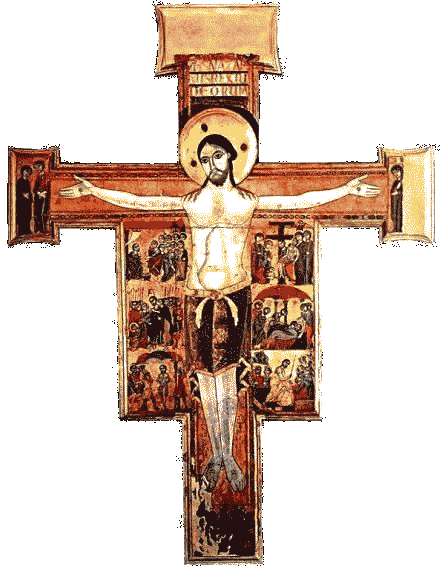|
NOTES ON
ICONOGRAPHY
IN THE EASTERN CHRISTIAN TRADITION
By
Ibrahim Aboud

Historical testimonies and writings
of the early fathers of the Church indicate a very early beginning for
artwork in the Christian Church. Excavations in Antioch and Rome revealed
that early Christians depicted subjects which revolved around their faith
on the walls of their tombs. Furthermore, it is stated in the early
tradition that St Luke was the first to paint an icon of Mary and Jesus,
and later copies of that icon were preserved in Constantinople and Syria.
Early iconography probably emerged in Syria and Egypt, and early
iconographers were very careful when depicting Holy figures. They used
symbols such as the cross, the fish, and the bird. Showing pain was seen
as contradictory to the triumph of resurrection. Therefore, even the
Crucified was shown on the cross with his eyes wide-open.
Many of the greatest fathers of the Church were very suspicious of
iconography and art in general. They feared a return to idolatry among the
new pagan converts, and thus restricted the use of art in all its forms.
The Church began to develop its own art however, and taking into
consideration the legitimate fears of the Fathers, they gave birth to a
form of art that sprang from.
Without indulging in the worries and appearances of this world's art,
early Christian artists painted simple figures that represented events
from the Holy Bible or the lives of the saints. These illustrations became
the earliest and most spread gospel. The Christian masses, educated and
uneducated, Roman and Barbarian, were able to receive the message of the
Church. The message was clear and simple: "Christ is risen from the dead,
trampling down death by death, and among those in the tombs bestowing
life." The greatest event for the early Church was the Edict of Milan in
313, which allowed Christians to worship freely, and thus express their
faith more openly. This led to depicting figures rather than symbols, and
a variety of biblical events became the subject matter of icons.
As iconography prospered, a strong resistance to arts began to emerge in
the Empire. In 726 Emperor Leo III ordered the destruction of all Holy
Icons, and thus began a long and bloody struggle for their restoration,
which ended with the victory of Orthodoxy under Empress Theodora in 843.
The disputes and debates that took place during this war helped define
certain rules and limitations for icons, and identified the theological
basis that formed Christian iconography and distinguished it from any
other form of art which can reflect incorrect theological ideas or plain
idolatry.
In 988, the Russian Prince Vladimir accepts Christianity, and iconography
is introduced into Russia. Over the years the Slavonic influence becomes
obvious. The figures in the icons are taller like the churches, and more
attention is paid to the shade and light at the time of the European
renaissance.
Holy icons are produced today in Orthodox monasteries, throughout the
world, for sacred use. Such artists prepare themselves spiritually before
attempting to depict Holy figures. In addition to those, many secularist
artists took iconography as a business, and kept painting beautiful
replicas, even during the communist era. In such an inappropriate
environment, an icon loses its function in human life.
Icons are not objects of worship, but are venerated as visual
representatives of the divine world. The colors, shapes, and signs are all
treated with much symbolism. Icons are strictly evaluated by the Church,
and restricted within a theological frame that decides what is
artistically changeable, and what is doctrine that must not be touched.
The Iconographer's Guide for the monks of Mount Athos forbids any
depiction of the Heavenly Father. Any depiction of the Father must be
either symbolic or through Christ himself, being the image and glory of
the Father. The Mother of God, on the other hand, should not be
illustrated alone, but is always accompanied by her son or a saint. Red in
most icons of Christ and the Theotokos implies the divine nature, while
green or blue imply human nature. The background is usually in gold to
display the glory of the divine world. The halo is not a symbolic oval
ring around the head, as in Western icons, but is rather an indication of
the light of God glowing through the person and united to the transfigured
surrounding as well.
Orthodoxy, unlike the Western Church, suffered a harsh struggle for holy
arts. Therefore, there is a strong rejection to three-dimensional works of
art, or any display of human muscular structure. Only the material
physical world is three-dimensional; the divine is simply indicated in two
dimensions. The faces of the figures hold only the main features they had
while in this life, and should not be excessively shaded and detailed. In
other words, the icon is trying to transform us into a world that is not
passing or physical: a world of glory and holiness, where human passions
and weaknesses have no power before the grace of the Holy Spirit.
Saint John of Damascus, who was raised in the Islamic court and later
became a monk in Palestine, strongly defended iconography by saying: "If
we have understood that the One Who is without a body has become man for
us, then it is clear that we can represent His image. Because the
Invisible One has become visible when He took on flesh, we can create the
image of what has been seen." In the final analysis we can only confess,
in faith, the substantial importance of iconography to the spiritual life
of Christians, and observe with reverence how it reflects and receives its
essence from the incarnation of the one and only Savior of the world, Our
Lord Jesus Christ.
*This article first appeared in the November 2002 issue of The Word
Magazine. Vol. 46 No. 9. http://www.antiochian.org/sites/antiochian.org/files/imagecache/pdf_thumbs/Word200211.pdf
|